
|
Sale 73
The Manuscript, Space & Collectibles Auction
| Lot |
Photo |
Description |
Realized |
Lot 616 |
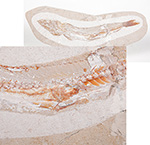 |
100 Million Year Old Fish With Another Fish in Its Stomach, This interesting 100 million year old fish Prionolepis from Lebanon is complete with excellent detail on a 11 x 4 inch cream colored limestone slab. What makes it so special is that within its stomach is its last meal, a 2 inch long fish that was swallowed whole and is still preserved intact with a clearly preserved head, bones, and its tail facing the head of the Prionolepis which meant it was swallowed head first. This fascinating fossil has the orange brown fish nicely contrasted against the cream colored matrix.
Add $25 for domestic shipping.
Estimated Value $700 - 1,000
View details and enlarged photo
| Unsold |
Lot 617 |
 |
210 Million Year Old Ichthyosaur Aquatic Reptile, Ichthyosaurs were a fast swimming marine reptile that have been extinct for more than 100 million years and somewhat resembled dolphins in shape. Their bodies were built for speed like a dolphin but their skeleton was very different. The earliest ichthyosaurs were much more reptile-like with longer thinner bodies and smaller fins and paddles. Mixosaurus panzianensis found in the 210 million year old Guaning Formation of Panxian County, China is one of the earliest and most primitive of ichthyosaurs. It had a long thin body with heavy vertebrae and a straight reptile- like tail (not curved like the later ichthyosaurs). This 21.5 inch long specimen is more complete than most specimens even though the ribs and some of the leg bones are disarticulated, but it's vertebrae, tail and parts of all four paddle bones are present. The large skull is 5 inches long with several sharp teeth still present in the jaw and Mixosaurus had a very large eyes which may indicate that it swam at somewhat great depths in search of prey. The 1 inch long paddles are just reptile feet with a few extra phalanges extending their length to create paddles for swimming and steering. This rare and important early ichthyosaur fossil is nicely centered on a 23 x 11.5 inch black stone matrix that has been backed for stability as the black matrix is somewhat fragile and all the recovered specimens always come out in a number of pieces. There is 10-15 percent restoration on some of the teeth, but overall this specimen is one of the finer fossils available of this rare primitive ichthyosaur and an opportunity to purchase an Ichthyosaur for less than the usual $10,000 or more.
Add $75 for domestic shipping.
Estimated Value $3,500 - 4,500
View details and enlarged photo
| Unsold |
Lot 618 |
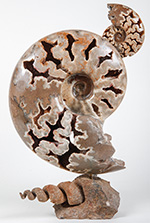 |
Ammonite Sculpture, Ammonites were cephalopods that looked liked a squid in a spiral shaped shell. This esthetic 14.5 x 7.5 inch sculpture features two 100 million year old golden brown ammonites, Phylloceras from Sidi Yahya Said, Morocco positioned atop a 8 inch long base containing a large Turitella snail shell. The large Phylloceras ammonite is very large 10 inches in diameter, and beautiful with colors blending from cream to golden brown, and inner chambers looking like the inside of a geode with tiny brown calcite crystals. The smaller 4.5 inch ammonite has colors blending from cream to orange to light grey. The walls of some of the chambers called Septa have dissolved away leaving the squiggly pattern of the sutures which strengthened the ammonites shell when it was alive. The back side of each ammonite is solid and clearly shows the colorful golden brown suture lines. Photos do not do justice to this exquisitely colorful and ornate ammonite sculpture which has both natural and esthetic beauty.
Add $30 for domestic shipping: $30.
Estimated Value $1,500 - 2,000
View details and enlarged photo
| Realized
$1,320 |
Lot 619 |
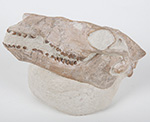 |
Camel Fossil Skull, Many strange and unusual mammals were found in western Nebraska and South Dakota 30-40 million years ago. Their rare and valuable fossils are sometimes found in the White River Badlands where they are uncovered by rain, wind and frost and are quickly destroyed unless they are found and collected. Poebrotherium was one of the very first camels over 30 million years old which originated in North America and not in Asia. It was the size of a sheep and lived in herds standing only about 30 inches tall. It had longer hind legs than forelegs and was built for speed. This virtually complete skull is 8 x 2.5 x 3.5 inches and is still positioned on the stone matrix as found in Sioux County Nebraska. The quality is outstanding with just the very front teeth restored. A rare and important fossil that is seldom found so complete.
Add $25 for domestic shipping.
Estimated Value $1,300 - 1,800
View details and enlarged photo
| Unsold |
Lot 620 |
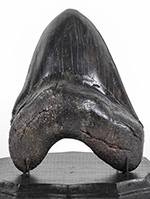 |
Carcharodon megalodon Shark's Tooth, Even though Carcharodon megalodon was the largest shark that ever lived growing to more than 50 feet in length, most of the teeth found are only 3-4 inches in length. Teeth over 5 inches in length are in great demand and the magic number is a full 6 inches, which is the size that every collector aspires to own. This immense 6.35 inch long 4.5 inch wide 15 million year old Carcharodon tooth was found in the muddy river waters of South Carolina. Estimating the length of a shark at about 10 feet in length to every one inch of tooth, this behemoth would be over 60 feet long. This huge tooth has fairly complete black enamel on both the front and back but does have about 10-15% repair of the left side of the blade and about 10% restoration on the top of the black front root. This is an opportunity to purchase a really huge shark's tooth without paying well over $1500. Comes with a 7 x 5 inch custom wooden black stand for display.
Add $15 for domestic shipping.
Estimated Value $500 - 750
View details and enlarged photo
| Realized
$480 |
Lot 621 |
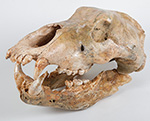 |
Cave Bear Skull, Cave bears were larger than any bear alive today standing over 10 feet tall. Certainly, the fierceness of their skull bears witness to this. This virtually complete 16 inch long skull has top quality ivory colored bone with a complete upper skull with large 2 inch long canine teeth missing only one of the small front teeth and repair of the zygomatic arch on the right side of the skull. The bottom jaw is missing one of the small front molars as well as three of the front teeth and also part of the thin bone that extends upward from the back of the jaw(this does not show when both the skull and jaw are joined together. Ursus spelaeus lived 50,000-100,000 years ago in Romania and other parts of northern Europe and certainly competed with early man in these areas. The earliest flute-type instrument was made out of a Cave Bear limb bone by Neandertals. Cave Bear skulls are in great demand because the few skulls found are usually mounted with the rest of the skeleton to bring many thousands of dollars. This is an opportunity to acquire an impressive skull with a few defects without paying over $6,000.
Add $50 for domestic shipping.
Estimated Value $2,400 - 2,800
View details and enlarged photo
| Realized
$2,142 |
Lot 622 |
 |
Complete Dinosaur Feather, At 125-135 million years old this large 1.5 inch dinosaur feather is one of the oldest feathers known exceeded in age only by the 150 million year old Archaeopterix bird feather from Solnhofen. This long feather is symmetric which means that it is not a flight feather such as those found on birds. The center rachis is thin and highly flexible as the feather is gently curved to the left but the entire feather is still covered with many filaments with remarkable detail showing delicate veining of the individual barbs. Even though this fossil feather is dark brown, that is from the mineralization of the fossilization process. The actual color of the fossil was probably much different and remarkably can now be determined analyzing the shape of melanosomes (pigment cells) by electron microscope. Comparing similar shaped melanosaomes in modern birds and what colors they created, the color of the dinosaur feathers can be obtained.
Whites, blacks and reddish browns have been identified. This important feather was found in a fossilized volcanic lake bed in Liaoning in Northeastern China, the sight where many types of feathered dinosaurs have been discovered. Although it is impossible to distinguish between bird and dinosaur feathers, the only flightless animals found in Liaoning have been theropod dinosaurs so the probability is great that this feather is indeed a theropod (meat eating) dinosaur feather that was either on its head or neck as a display feather to attract a mate or from one of its arms. This valuable and rare dark brown dinosaur feather is centered on a 4 x 4 inch dark gray matrix and housed in a 8 x 6.5 inch Riker mount.
Add $15 for domestic shipping.
Estimated Value $550 - 750
View details and enlarged photo
| Realized
$552 |
Lot 623 |
 |
Complete Mammoth Tusk, Complete tusks from a wooly mammoth Mammuthis primigenius are rare. This complete 29 inch long tusk is from a juvenile Mammoth, most probably a male because of its length and small diameter (2 inches). It is complete with the distinctive natural curve that defines a Mammoth tusk and has been lightly polished revealing mostly warm creams and chocolate brown colored ivory. These brown colors resulted from the original white ivory being mineralized over thousands of years with minerals such as vivianite and iron phosphate. The tusk is nearly perfect except for a little natural wear of the ivory on the tip of the tusk which was worn down while the Mammoth was still alive. This museum quality tusk was found in Alaska which is a scarce location as most Mammoth fossils are found in Siberia or the North Sea, and it is between 30,000 and 100,000 years old. Most recovered Mammoth ivory is just broken pieces unlike this over 2 foot long curved exceptional quality tusk. The only ivory that can be legally sold is fossil ivory. Comes with a display stand.
Add $40 for domestic shipping.
Estimated Value $1,500 - 2,000
View details and enlarged photo
| Unsold |
Lot 624 |
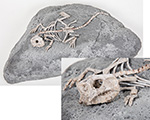 |
Complete Psittacosaurus Dinosaur, Psittacosaurus is a very important dinosaur that lived between 120-130 million years ago in Liaoning Province, Central Asia. Psittacosaurus is important as being the oldest ancestor of the famous horned dinosaurs such as Triceratops. Psittacosaurus did not have horns but did possess a horned beak and bony Jugals (back of the upper jaw) which are characteristic of only ceroptopsian (horned) dinosaurs. Psittacosaurus is the most studied of all dinosaurs because it is known from all stages from hatchling to adult. With eggs about 3 inches long, the hatchlings were about 6 inches long. Even though Psittacosaur nests contained no more than 24 eggs, an adult Psittacosaur over 4 feet long was found fossilized with more than 65 juvenile Psittacosaurs none larger than 19 inches long suggesting that baby Psittacosaurs were kept in their nesting area as they grew from 6 inches to as much as 19 inches in length and were protected and probably fed by adult Psittacosaurs. This 11 inch long baby Psittacosaur is the smallest mounted dinosaur ever offered at auction and consists of at least 85% real bone, missing only the small delicate neural spines along the back and tail and the rib bones which were reconstructed. The great preservation of the small delicate bones occurred because this dinosaur was instantly buried under volcanic ash over 120 million years ago, a sort of dinosaurean Pompei. The all important 3-D skull is 1.5 inches long with no distortion and all of the matrix completely removed from inside the skull and with some real teeth on both the upper and lower jaws. This small complete dinosaur has been repositioned in a natural looking display of the bones atop a 15 x 9 inch faux rock and would make an excellent desk or even wall display.
Estimated Value $5,000 - 7,000
View details and enlarged photo
| Unsold |
Lot 625 |
 |
Dinosaur Egg Museum Quality, This large complete unhatched Duckbill dinosaur egg is 70-80 million years old 6.5 x 4.5 inches and of museum quality with over 90 percent of its original shell intact. The egg is completely original and the color varies from white covered calcite to brown where the calcite is very thin and has just a few spots on the top of the egg where the reddish brown matrix shows through. The egg is sitting on some of the original reddish-brown matrix that has been flattened on the bottom for a stable dramatic display.
We do not know to what Duckbill species this egg belongs as no embryonic bones have every been found in the Duckbill dinosaur eggs, but being the largest Duckbill egg at a gigantic 7 inches in length (most eggs being 5-5.5 inches long), it might belong to the huge Duckbill dinosaur Shantungosaurus which reached more than 50 feet in length and has been found in the same area in the Henan Province of China. This museum quality dino egg makes an excellent display having much more original egg shell than normally found and rests on a small section of its reddish brown limestone matrix. Dinosaur eggs are becoming hard to locate and rising sharply in value.
Add $30 for domestic shipping.
Estimated Value $700 - 900
View details and enlarged photo
| Unsold |
Lot 626 |
 |
Dinosaur Egg Unkown Type of Dinosaur, This prepped complete dinosaur egg is 70-80 million years old measuring 4.75 x 4.25 inches and of excellent quality with over 80 percent of its original shell intact. The egg is completely original and has been professionally airbrushed to remove all of the minerals covering the original shell leaving the shell exposed with its chocolate brown color. The important question is just what type of dinosaur deposited this egg. The exact type of dinosaur cannot be determined unless an embryo is found within it. There are many types of dinosaurs but only a handfull have been identified from embryonic bones. What we do know about this mysterious egg is that it's from a plant eating dinosaur and not a theropod (different shape). Also, it is different from the common duckbill dinosaur eggs in both its shape (more spherical) and also the thinness of its shell. It isn't a sauropod egg which is spherical with a black shell preservation. It could be from an armored dinosaur or an ornithomimid (an ostrich type dinosaur) such as Ornitithomimus. Both of these types of dinosaurs have been found in the same area in the Henan Province of China where this egg was recovered. Also, these smaller thin shelled eggs are never found in large nesting areas with hundreds of eggs that define duckbill dinosaurs but rather in isolated nests which could point to an armored dinosaur. Until a complete armored or onithomimid dinosaur is found, the mystery of this dinosaur egg will remain. This interesting dino egg makes an excellent display still standing on a small section of its reddish brown limestone matrix.
Add $20 for domestic shipping.
Estimated Value $800 - 1,200
View details and enlarged photo
| Unsold |
Lot 627 |
 |
Dinosaur Skin With Soft Tissue, Dinosaur skin is the rarest and most coveted of dinosaur fossils because of its extreme rarity being preserved only under extraordinary conditions. The dinosaur had to have been completely covered by fine mud sediments probably in a large river delta within a day or so after dying to avoid bacterial breakdown of the skin and soft tissue which would occur immediately. This type of extreme condition may have occurred in a massive flood. The skin texture was impressed in detail in the soft clay forming a natural mold which was later filled by more muddy sand creating a natural cast and remained intact for over 65 million years even after the skin and other soft tissue was destroyed by bacteria. This large section of dinosaur skin is from the back of the hip or tail section of an Edmontosaurus duckbilled dinosaur and is between 65-70 million years old and was found along with some fragmented Edmontosaurus bones in the Hell Creek Formation of Montana. Also only found on "dinosaur mummies" soft tissue has also been fossilized along with the skin. The soft tissue could be muscle or glands but it is something that was just beneath the skin. The answer might be coming soon as a more complete Edmontosaurus with soft tissue has been found and was featured on a National Geographic Show titled "Dinosaur Autopsy " with a book coming out later this year.
This large section of matrix is 9 x 4 inches and has deep, very distinct skin impressions on both sides of the limestone rock. The best detailed skin is 4 x 2 inches showing excellent detail and color. Also present on the bottom of the slab is a 3 x 2 inch dark brown imprint of the muscle or gland that was present just beneath the skin. Also included is the negative of this rare undescribed duck billed dinosaur soft tissue. The negative section shows straight creases running the entire length of the muscle or gland. These wrinkles or creases could have resulted from the fossilized soft tissue drying out in the fossilization process. All of the color is original just as found when this rare specimen was broken out of a larger piece of rock. The Dinosaur Autopsy show called their find the most important of the decade, and an offering of dinosaur skin with soft tissue preservation may never be offered for sale again.
Allow $25 for domestic shipping.
Estimated Value $1,000 - 1,250
View details and enlarged photo
| Realized
$780 |
Lot 628 |
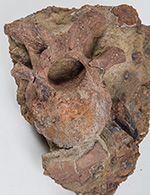 |
Dinosaur Vertebrae With T-Rex Tooth, This large 10 x 7 inch block of 65 million year old sandstone was found in the famous Hell Creek Formation of Eastern Montana on a private ranch and contains a near complete 6X5 inch cervical vertebrae (neck) from an adult duck billed dinosaur(also known as a hadrosaur dinosaur) as well as a 1.5 inch long T-Rex tooth. This in situ display has had no restoration and includes numerous other fragments of dinosaur bone on both sides of the matrix probably resulting from the T-Rex meal. The T-Rex tooth is a shed tooth (no root) which resulted from its biting through dinosaur bone and is in place just as found with a dark brown enamel that is somewhat worn and weathered. This is an extraordinary opportunity to acquire bones from a T-Rex feeding with one of its teeth found along with the prey dinosaur's bones.
Add $30 for domestic shipping.
Estimated Value $750 - 1,000
View details and enlarged photo
| Realized
$630 |
Lot 629 |
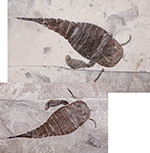 |
Eurypterids, Sea Scorpions Positive and Negative Slab, Eurypterids, also known as sea scorpions were fierce predators in the warm seas 425 million years ago. They grew to over 6 feet long and easily hunted the slow moving armored fish of that era. Eurypterids were related to scorpions and were probably the first animal to leave the sea and crawl out on dry land. This highly detailed sea scorpion, Eurypteurus lacustris comes from the famous 425 million year old Fiddler's Green Quarry of Herkimer County, New York. This large specimen is 5 inches long having one paddle, a repaired telson (looks like the stinger in a scorpion but was not poisonous) and two of the six walking legs. These delicate walking legs are rarely preserved. What makes this specimen so unusual is that both the positive and negative slabs (7x6 inches) were preserved when the super hard grey rock was split to reveal its fossilized treasure inside. Usually, because the rock is so hard, at least one of the halves breaks into many pieces. There is one repaired break line in both the positive and negative halves but this doesn't affect the body detail on the scorpion. Both halves are included in this lot.
Add $30 for domestic shipping.
Estimated Value $1,000 - 1,250
View details and enlarged photo
| Realized
$840 |
Lot 630 |
 |
Huge Spinosaurus Dinosaur Tooth, Made famous in "Jurassic Park III" as the dinosaur that killed a T-Rex, the enormous 80 million year old theropod dinosaur Spinosaurus with a huge sail on its back remains an enigmatic dinosaur as no skeleton even remotely complete has been found and the only partial skeleton was destroyed in World War II. Spinosaurus is mostly known from its teeth which are fairly common but usually less than two inches long, broken, and ugly. This huge 4.75 inch tooth is the exception having lovely brown colored enamel and a large section of cream colored root with just some of the usual cracks in the enamel with a small amount of natural wear on the tip. This natural wear on the tip occurred when the Spinosaurus was alive. This rare dinosaur teeth was found in the Kem Kem Valley near Taouz, Morocco (near the border with Algeria). This museum quality fossil is housed in a 8 x 6 inch Riker mount.
Add $15 for domestic shipping.
Estimated Value $600 - 800
View details and enlarged photo
| Unsold |
Lot 631 |
 |
Juvenile Cave Bear Foot, Ursis spelleus, between 20,000 and 50,000 years old. 10½ inches long x 5 inches wide. Either from Rumania or Russia.
Estimated Value $350 - 450
View details and enlarged photo
| Realized
$132 |
Lot 632 |
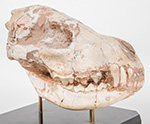 |
Mammal Hyena Ictitherium Skull, This excellent complete 26 million year old fearsome mammal skull belonged to one of the earliest types of Hyenas that looked vastly different from the Hyenas that exist today. Hyena ictitherium lived in eastern Asia and looked something like a Civet with a long 4 foot body and short powerful legs. Their massive skulls with sharp over one inch long canines clearly show that they were carnivorous and likely hunted in packs. This museum quality skull was prepared out of the original matrix with some of the matrix still inside of the skull. The skull measures 8.5X5 inches and is virtually complete with just some cracks in skull but with all of the teeth present although some of the teeth have been placed back into position into the skull. This rare and impressive skull has been mounted on a 6X6 inch custom black Lucite stand making for a very impressive display of a rarely offered predatory fossil.
Add $25 for domestic shipping.
Estimated Value $1,700 - 2,200
View details and enlarged photo
| Unsold |
Lot 633 |
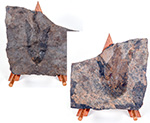 |
Pair of Positive and Negative Dinosaur Footprints, This highly unusual pair of rare fossil dinosaur footprints on a 9 x 8 inch gray shale slab contains a positive and a negative fossil footprint from the same dinosaur, a 6 x 2.5 inch raised negative footprint on one side and a 6 x 3 inch positive footprint on the other side. Because the slab is very thin these footprints belong to the same dinosaur and were made at the same time. These 187-208 million year old footprints from the East Berlin formation of West Springfield Massachusetts are known as Grallator cuneatus and were made by a meat eating dinosaur similar to Podokesaurus, a medium sized theropod, whose partial skeleton was found in the same area. These footprints are complete even showing the claw imprints. This rare pairing of the same dinosaur also illustrates how the shape of the footprint differs in the positive and negative impressions with the toe impressions being thicker and larger in the positive.
Add $15 for domestic shipping.
Estimated Value $450 - 600
View details and enlarged photo
| Realized
$468 |
Lot 634 |
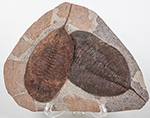 |
Pair of Rare Large Trilobites, Trilobites are one of the most popular fossils with collectors because of their strange appearance and attractiveness when well preserved with excellent detail on their hard shell parts. There are over 14,000 different species of trilobites which are arthropods and ancestors to insects and crustaceans. This pair of very large 6 inch 510 million year old dark brown trilobites are rare and belong to a recent discovery made in Essembra, South Morocco. Mucronaspis zagoraensis is very distinctive from most trilobites in that it has a very long tail spine (almost 2 inches). What also makes this 9 x 6.75 inch original slab special is the size of these trilobites at 6 inches including the tail spine. Usually only found as singles and only 2-3 inches long this pair is as large as this species gets. The dark brown color of the trilobites is nicely contrasted against the light brown and light gray matrix.
Add $15 for domestic shipping.
Estimated Value $550 - 750
View details and enlarged photo
| Realized
$480 |
Lot 635 |
 |
Six Trilobites, Six dark brown trilobites on a 7½ x 6 inch gray matrix, from the Atlas Mountains of Morocco, 375 million years old. Five Odonto cephalu: one is 3 inches long, two are 2 inches; two other partial trilobites, with heads encased in the matrix, are 1½ and 2 inches. One other trilobite, species unknown, is 2¾ inches.
Estimated Value $250 - 350
View details and enlarged photo
| Unsold |
Lot 636 |
 |
Starfish and Crinoids, Starfish and crinoids known as "sea lilies" are related as both belong to the genus Echinoderms. The same five-fold symmetry is present in crinoids with the number of their feeding arms being a multiple of five. This highly detailed 9.5 x 6 inch fossil slab is 450 million years old and was found in the Sahara desert of Morocco. The 3-D starfish is 3.5 inches long and complete. The three crinoids vary in length from 2.5-6.0 inches and consist of a crown along with some of their delicate stem still preserved intact. The crown is made up of the mouth and feeding arms which caught detritus and small crustaceans.
Add $20 for domestic shipping.
Estimated Value $550 - 700
View details and enlarged photo
| Unsold |
Lot 637 |
 |
Struthiomimus Toe With Claw, Struthiomimus (name means ostrich mimic) was a fast running bipedal ostrich-type dinosaur that lived in Eastern Montana 70-75 million years ago. It is estimated that this dinosaur could run at speeds between 30-50 mph. This medium size plant eating or omnivore dinosaur was about 14 feet long and most likely was feathered. This complete toe with metatarsal bone is 11 inches long with the only restoration being the upper half of the metatarsal bone. The sharp claw is 2.5 inches long and would have been quite an effective weapon being kicked at high speed at a predatory dinosaur. Has been mounted on a 12 x 5 inch wooden base making for an excellent display. From a private ranch in Eastern Montana.
Add $20 for domestic shipping.
Estimated Value $1,600 - 2,200
View details and enlarged photo
| Unsold |
Lot 638 |
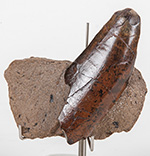 |
T-Rex Tooth in Matrix, All fossils from a T-Rex are rare and in tremendous demand. Large teeth are the most desired of T-Rex fossils. This 66 million year old 2.75 inch tooth was found on a private ranch in the late Cretacious rocks of Drumheller, Alberta. The tooth was professionally prepared and left in a small 2.5 x 1.5 inch stone matrix. for a dramatic display. The 2.75 inch tooth has a lovely chocolate brown color enamel with some cracks filled, serrations on the bottom side, some natural tooth wear that occurred when the T-Rex was alive and some minor chips on the tip. Virtually all large T-Rex teeth have cracks in the enamel that have to be stabilized. With large T-Rex teeth selling for more than $1500 per inch, this less than perfect large shed tooth should be an excellent inexpensive alternative to acquire an impressive T-Rex tooth with good enamel. The tooth comes with a 2 inch high illusion stand for display.
Add $20 for domestic shipping.
Estimated Value $900 - 1,200
View details and enlarged photo
| Realized
$788 |
Lot 639 |
 |
Three Crinoids From the Famous Crawfordsville, Indiana Beds, About 300 million years old. 10 x 8½ inch gray matrix contrasting with the brown crinoids. One crinoid is 8½ inches long, of which 4 inches is the crown and 4½ inches the stem; four of the five arms are visible. A second crinoid is 7 inches, of which 2 inches is the crown and 5 inches the stem; all five arms are visible, as are the delicate pinnules used to filter feed. A third, partial, crinoid is 4 inches, with a 1¼ inch crown and 2¾ inch stem; just two arms are visible. Museum quality.
Estimated Value $400 - 600
View details and enlarged photo
| Realized
$312 |
|
|